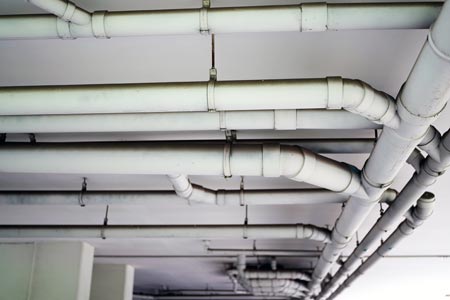How to Overcome Gravity in High-Rise Plumbing Systems
March 2023
By Bill Ivey
Principal Consultant
Plumbing systems for tall buildings are more complex than other plumbing systems. This complexity is mostly the result of gravity. As Sir Isaac Newton discovered three centuries ago, objects that fall pick up speed and objects that rise must overcome the force of gravity to rise. Here we’ll discuss single-stack waste and domestic water systems—two examples of plumbing systems that require the designer to pay particular attention to gravity.
Single-Stack Waste
Single-stack waste and vent sewage systems, also called engineered systems, eliminate the parallel vent stack of a conventional system and use one stack for both waste and venting. In order to do this the waste stack is increased in size and has an aerator fitting or offsets at eachfloor to reduce the velocity of the sewage. Venting is very important or the sewage will not flow properly. Improper venting may cause siphoning in the fixture traps, which allows sewer gases to enter the building.
The most widely used single-stack system is the Sovent system. It was developed 60 years ago in Europe and utilizes certain proprietary fittings and strict design and installation standards. These systems were initially utilized in the United States for high-rise hotels. They are now widely used for high-rise commercial and residential buildings. Another such system is the Philadelphia single-stack system. It is only used in certain parts of the country, including (you guessed it) Philadelphia.
The plumbing codes consider these single-stack waste and vent systems to be “engineered systems”. They usually are submitted to the local building department for approval prior to use, and require strict adherence to the manufacturer’s design and installation requirements.
High-Rise Domestic Water
High-rise domestic water systems have to be designed to account for gravity. This requires a booster pump to deliver water to the upper floors. To avoid over pressuring the lower floors, pressure reducing valves (PRVs) are usually installed so that the 80 psi code maximum pressure is not exceeded on the lower floors.
High-rise buildings present another problem with regard to delivery of hot water. Unless properly addressed, the hot water would cool in the pipes during off-peak usage periods. To overcome this, plumbing designers add small pumps and sometimes small water heaters to constantly circulate hot water, thus maintaining the temperature in the distribution system. This assures delivery of hot water to the various fixtures within reasonable time from opening a faucet or mixing valve.
High water velocity in domestic water systems can result in piping damage, especially in copper plumbing systems. Plumbing designers have to be aware of this and size the piping and pumps to maintain maximum velocities below threshold levels.
Plumbing systems for tall buildings are complex, mostly due to the result of gravity.
To account for gravity, high-rise domestic water systems require a booster pump to deliver water to the upper floors.







